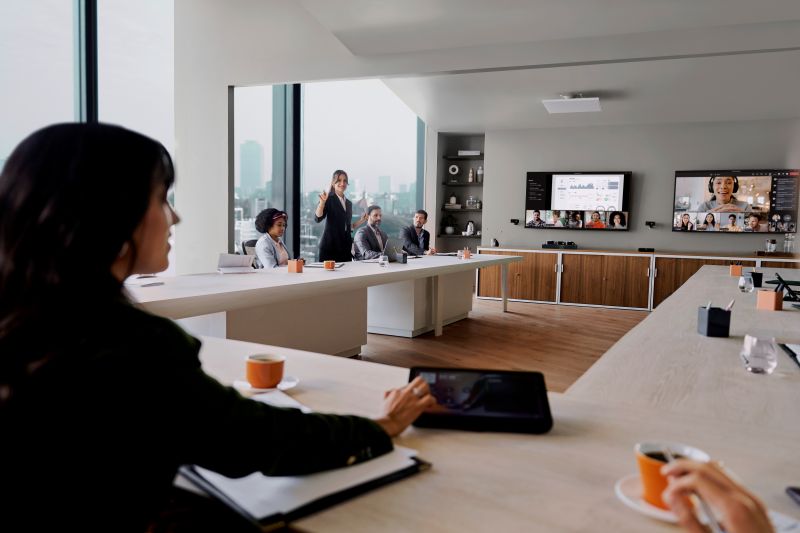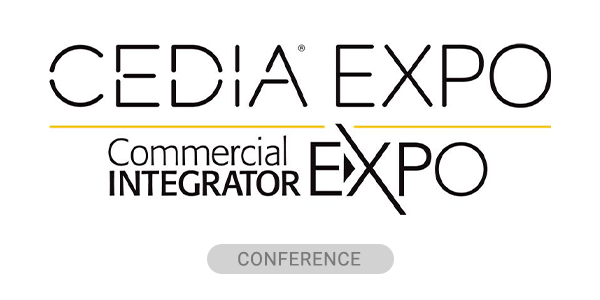The modern workplace is in constant flux, requiring organizations to adopt new tools and technologies to address evolving workforce needs. From cutting-edge digital tools and AI assistants to innovative office designs and flexible work arrangements, the landscape of hybrid work and collaboration is set to transform remarkably as we look toward the rest of 2025 and into 2026.
Advanced Collaboration Tools
Over the next few months, unified communication platforms, such as Microsoft Teams and Zoom, will evolve to offer even more seamless transitions between day-to-day operations like video conferencing, chat, file sharing, and project management functionalities.
AI tools have exploded in the first half of 2025. Over the last six months, we’ve seen increased adoption and companies introducing proprietary AI companion tools, including Copilot in Microsoft Teams, for internal use. However, there remains a need for greater integration to enable employees to collaborate more effectively, both within and outside of their organizations. Users increasingly expect a seamless experience, regardless of who they are talking to, where that person is located, or their communication channels.
AI is a driving force in this push to integrate multiple functionalities into a single, unified system. Though there is a learning curve, employees are also seeing its potential to improve collaboration in in-person and hybrid meeting environments by streamlining communication, automating routine tasks, and enabling real-time data sharing. These tools can converge to improve the employee experience, but employees need to be willing to adopt them for it to work effectively. As proficiency with AI grows, its adoption will rise, providing enhanced productivity and efficiency for both employees and employers.
AI and Machine Learning
AI has the potential to transform how people collaborate within meeting rooms, but we aren’t fully there yet. The use of AI in physical spaces has practical limitations, and spaces need to be designed for employees to experience its benefits.
AI alone struggles to interact with the physical world. It can’t anticipate the variability that exists in the physical environment and requires hardware like microphones and cameras to fully capture in-room activity. For example, Microsoft Teams Rooms use AI-powered cameras to focus on active speakers, improving the experience for employees in a conference room. Coupled with tech like room sensors, AI can help employers see when, how, and why certain rooms are being used to better inform real estate planning, workspace utilization and improvements. Emerging use cases include using high-quality microphones for more accurate transcription and to prompt AI in collaboration spaces – such as introducing in-room meeting participants to Copilot in Microsoft Teams for personalized note taking, sending recaps to attendees, or scheduling future meeting and booking rooms.
Heading into 2026, IT teams need to evaluate their current setup and adoption of AI tools to make sure they’re optimized to adopt the technology. We’ve already seen improvements and increased adoption this year, but physical spaces still need to evolve to provide the best possible meeting experience, ensuring that their hardware complements the software. This is particularly true in larger spaces where more advanced audio or video solutions may be needed to accurately capture activity and prompts. As AI capabilities grow and employees experience more seamless interaction with technology, companies will see improved collaboration and return on their investments.
Shift in Office Design
Despite continued return-to-office mandates, employees do not always follow expectations. IDC data suggests that many offices designed in pre-pandemic times are not fit for hybrid work, and organizations have started to invest in modernizing meeting spaces, but employees often struggle to achieve a satisfying conversation flow that enables all members to equally contribute to discussions.
According to data from JLL, 54% of Fortune 100 companies have implemented full, in office RTO mandates in the past couple of years. As employees transition back to in-person work, organizations that have made significant investments in conference rooms with the challenge of transforming these spaces into collaboration hubs that employees will want to use.
Organizations must show employees that they can deliver in-person and hybrid collaboration experiences on par with remote work experiences, and sometimes, effective conferencing technology can make all the difference. According to research from IDC*, commissioned by Shure, 72% of companies that are thriving financially are also likely to already be using professional audio.
Companies are prioritizing dependable, high-quality technology tools that rival at-home tools, but they need to ensure that they are intuitive and glitch-free, allowing straightforward scheduling and effortless connectivity. By choosing integrated solutions that work seamlessly, companies can ensure that hybrid meetings are as effective and stress-free as in-person or fully remote meetings—a critical advantage in maintaining an efficient and cohesive workforce.
Flexibility is a Non-Negotiable
Even as many organizations bring employees back to the office three, four, or five days a week, there will always be remote participants. Therefore, there will always be a need for effective hybrid work tools and flexibility. Companies are striving to create zero-friction collaboration experiences, reminiscent of pre-remote office interactions, but with today’s workplace considerations in mind. This is not an easy feat.
Now that we are past the mid-year mark of 2025 and looking ahead to next year, organizations need to double down on the right tech for collaboration. They need to ensure the right tools are in place for employees to succeed from anywhere in 2026. This evolving conversation is central to the success of all organizations as they adapt to a new era of work.
*IDC Infobrief, sponsored by Shure, The Hidden Influencer: Rethinking Audio Could Impact Your Organization Today, Tomorrow, and Forever, doc #EUR150735523, July 2023
Tyler Troutman, Strategic Market Development at Shure.
He has dedicated most of his career advocating as a voice of the customer to create innovative solutions that address and anticipate customer needs. With two decades of industry experience, Troutman has honed his skills by deploying solutions for organizations of various sizes and working directly with end users, gaining invaluable insights into the ever-evolving collaboration space. His extensive experience in the collaboration space has enabled Troutman to forge vital connections within the conferencing and installation communities, working collaboratively to address and solve industry challenges.





